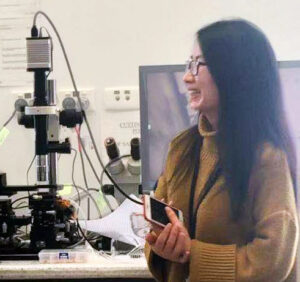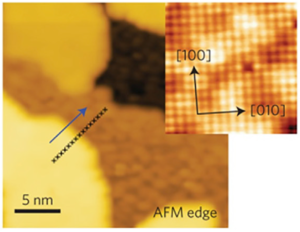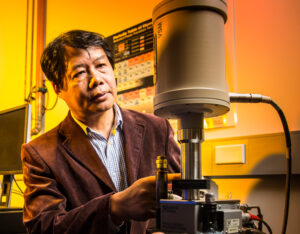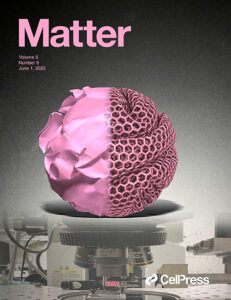
First author FLEET PhD student Lina Sang in the labs at the Institute for Superconducting and Electronic Materials (ISEM), University of Wollongong
- Majorana fermions promise information technology with zero resistance
A new, multi-node FLEET review investigates the search for Majorana fermions in iron-based superconductors.
The elusive Majorana fermion, or ‘angel particle’ proposed by Ettore Majorana in 1937, simultaneously behaves like a particle and an antiparticle – and surprisingly remains stable rather than being self-destructive.
Majorana fermions promise information and communications technology with zero resistance, addressing the rising energy consumption of modern electronics (already 8% of global electricity consumption), and promising a sustainable future for computing.
Additionally, it is the presence of Majorana zero-energy modes in topological superconductors that have made those exotic quantum materials the main candidate materials for realizing topological quantum computing.
The existence of Majorana fermions in condensed-matter systems will help in FLEET’s search for future low-energy electronic technologies.
The angel particle: both matter and antimatter
Fundamental particles such as electrons, protons, neutrons, quarks and neutrinos (called fermions) each have their distinct antiparticles. An antiparticle has the same mass as it’s ordinary partner, but opposite electric charge and magnetic moment.
Conventional fermion and anti-fermions constitute matter and antimatter, and annihilate each other when combined.
“The Majorana fermion is the only exception to this rule, a composite particle that is its own antiparticle,” says corresponding author Prof Xiaolin Wang (UOW).
However, despite the intensive searching for Majorana particles, the clue of its existence has been elusive for many decades, as the two conflicting properties (ie, it’s positive and negative charge) render it neutral and its interactions with the environment are very weak.
Topological superconductors: fertile ground for the angel particle

Scanning tunnelling microscopy (STM) images: edge of FeSe/STO, with inset atomic-resolution STM showing the topmost Se atom arrangement and crystal orientation
While the existence of the Majorana particle has yet to be discovered, despite extensive searches in high-energy physics facilities such as CERN, it may exist as a single-particle excitation in condensed-matter systems where band topology and superconductivity coexist.
“In the last two decades, Majorana particles have been reported in many superconductor heterostructures and have been demonstrated with strong potential in quantum computing applications” according to Dr Muhammad Nadeem, a FLEET postdoc at UOW.
A few years ago, a new type of material called iron-based topological superconductors were reported hosting Majorana particles without fabrication of heterostructures, which is significant for application in real devices.
“Our article reviews the most recent experimental achievements in these materials: how to obtain topological superconductor materials, experimental observation of the topological state, and detection of Majorana zero modes,” says first author UOW PhD candidate Lina Sang.
In these systems, quasiparticles may impersonate a particular type of Majorana fermion such as ‘chiral’ Majorana fermion, one that moves along a one-dimensional path and Majorana ‘zero mode’, one that remains bounded in a zero-dimensional space.
Applications of the Majorana zero mode
If such condensed-matter systems, hosting Majorana fermions, are experimentally accessible and can be characterized by a simple technique, it would help researchers to steer the engineering of low-energy technologies whose functionalities are enabled by exploiting unique physical characteristics of Majorana fermions, such as fault-tolerant topological quantum computing and ultra-low energy electronics.
The hosting of Majorana fermions in topological states of matter, topological insulators and Weyl semimetals will be covered in this month’s major international conference on the physics of semiconductors (ICPS), being held in Sydney Australia.
The IOP 2021 Quantum materials roadmap investigates the role of intrinsic spin–orbit coupling (SOC) based quantum materials for topological devices based on Majorana modes, laying out evidence at the boundary between strong SOC materials and superconductors, as well as in an iron-based superconductor.
The study
Majorana zero modes in iron-based superconductors was published in ‘Matter‘ (Vol. 5, Iss. 6, 1 June 2022, pp. 1734-59). DOI 10.1016/j.matt.2022.04.021
The work is supported by the Australian Research Council Centres of Excellence, Future Fellowship and Discovery programs, and combined research across FLEET’s University of Wollongong, RMIT University and UNSW, Sydney nodes, along with partner organisation Tsinghua University (China).
More information
- Contact corresponding author Prof Xiaolin Wang (University of Wollongong) xiaolin@uow.edu.au
Read more:
- UOW/Monash/ FLEET discovery of wide-bandgap topological insulator potential host for Majorana fermions
- FLEET/UNSW search for Majorana zero mode in 1D quantum nanowires (and transpacific colloquium)
- FLEET/RMIT theoretical study, applying Aharonov-Bohm interference to search for Majorana fermions toward topologically-protected transport
- FLEET/Monash coupling of superconductor and intrinsic magnetic topological insulator to allow chiral Majorana edge states
- FLEET/UNSW electric-field Zeeman splitting application to realising Majorana systems in p-type superconductor systems
- NTU study: Hosting of Majorana fermions in helical, superconducting 1D edge paths in quantum spin Hall insulators
- Transpacific colloquium: realising Majorana statistics in dissipationless edge states of helical conductors









